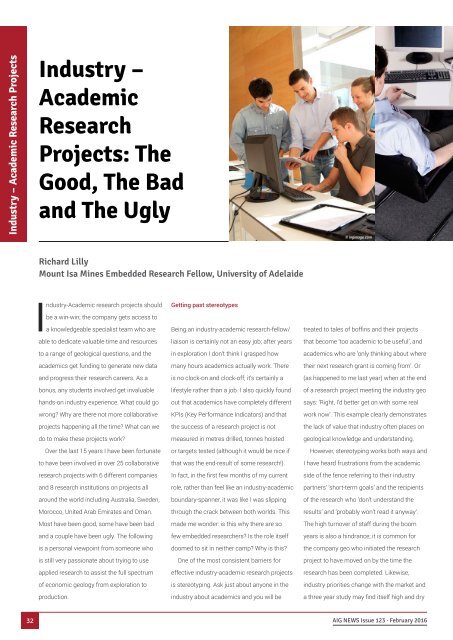Up & Coming Geoscientists - a sample of our AIG Honours Bursary Recipients
KMnJLq
KMnJLq
You also want an ePaper? Increase the reach of your titles
YUMPU automatically turns print PDFs into web optimized ePapers that Google loves.
Industry – Academic Research Projects<br />
Industry –<br />
Academic<br />
Research<br />
Projects: The<br />
Good, The Bad<br />
and The Ugly<br />
© ingimage.com<br />
Richard Lilly<br />
Mount Isa Mines Embedded Research Fellow, University <strong>of</strong> Adelaide<br />
Industry-Academic research projects should<br />
be a win-win; the company gets access to<br />
a knowledgeable specialist team who are<br />
able to dedicate valuable time and res<strong>our</strong>ces<br />
to a range <strong>of</strong> geological questions, and the<br />
academics get funding to generate new data<br />
and progress their research careers. As a<br />
bonus, any students involved get invaluable<br />
hands-on industry experience. What could go<br />
wrong? Why are there not more collaborative<br />
projects happening all the time? What can we<br />
do to make these projects work?<br />
Over the last 15 years I have been fortunate<br />
to have been involved in over 25 collaborative<br />
research projects with 6 different companies<br />
and 8 research institutions on projects all<br />
around the world including Australia, Sweden,<br />
Morocco, United Arab Emirates and Oman.<br />
Most have been good, some have been bad<br />
and a couple have been ugly. The following<br />
is a personal viewpoint from someone who<br />
is still very passionate about trying to use<br />
applied research to assist the full spectrum<br />
<strong>of</strong> economic geology from exploration to<br />
production.<br />
Getting past stereotypes<br />
Being an industry-academic research-fellow/<br />
liaison is certainly not an easy job; after years<br />
in exploration I don’t think I grasped how<br />
many h<strong>our</strong>s academics actually work. There<br />
is no clock-on and clock-<strong>of</strong>f; it’s certainly a<br />
lifestyle rather than a job. I also quickly found<br />
out that academics have completely different<br />
KPIs (Key Performance Indicators) and that<br />
the success <strong>of</strong> a research project is not<br />
measured in metres drilled, tonnes hoisted<br />
or targets tested (although it would be nice if<br />
that was the end-result <strong>of</strong> some research!).<br />
In fact, in the first few months <strong>of</strong> my current<br />
role, rather than feel like an industry-academic<br />
boundary-spanner, it was like I was slipping<br />
through the crack between both worlds. This<br />
made me wonder: is this why there are so<br />
few embedded researchers? Is the role itself<br />
doomed to sit in neither camp? Why is this?<br />
One <strong>of</strong> the most consistent barriers for<br />
effective industry-academic research projects<br />
is stereotyping. Ask just about anyone in the<br />
industry about academics and you will be<br />
treated to tales <strong>of</strong> b<strong>of</strong>fins and their projects<br />
that become ‘too academic to be useful’, and<br />
academics who are ’only thinking about where<br />
their next research grant is coming from’. Or<br />
(as happened to me last year) when at the end<br />
<strong>of</strong> a research project meeting the industry geo<br />
says: ‘Right, I’d better get on with some real<br />
work now’. This example clearly demonstrates<br />
the lack <strong>of</strong> value that industry <strong>of</strong>ten places on<br />
geological knowledge and understanding.<br />
However, stereotyping works both ways and<br />
I have heard frustrations from the academic<br />
side <strong>of</strong> the fence referring to their industry<br />
partners’ ‘short-term goals’ and the recipients<br />
<strong>of</strong> the research who ‘don’t understand the<br />
results’ and ‘probably won’t read it anyway’.<br />
The high turnover <strong>of</strong> staff during the boom<br />
years is also a hindrance; it is common for<br />
the company geo who initiated the research<br />
project to have moved on by the time the<br />
research has been completed. Likewise,<br />
industry priorities change with the market and<br />
a three year study may find itself high and dry<br />
32<br />
<strong>AIG</strong> NEWS Issue 123 · February 2016


